
Arx is a Latin word meaning "citadel". In the ancient city of Rome, the arx was located on the northern spur of the Capitoline Hill, and is sometimes specified as the Arx Capitolina.

Arx is a Latin word meaning "citadel". In the ancient city of Rome, the arx was located on the northern spur of the Capitoline Hill, and is sometimes specified as the Arx Capitolina.
At Rome, sentries were traditionally posted on the Arx to watch for signals displayed on the Janiculan Hill if an enemy approached. [1] A red flag would be raised [2] and a trumpet blown. [3] The Arx was not regularly garrisoned, however, and should not be regarded as a "fort." However, in the Gallic siege of Rome (387 BC), the Arx was considered the point of last retreat, the capture of which was synonymous with the capture of the city. It thus held a symbolic power beyond its importance in military strategy, and was a central place in archaic Roman religion.
During the regal period, some members of the elite were permitted to live on the Arx, among them the legendary Sabine leader Titus Tatius. After 384 BC, the Senate banned all private dwellings from the Capitoline Hill, including the Arx. The house of Marcus Manlius Capitolinus, a patrician champion of the plebs who was convicted of seeking kingship, was torn down at this time and later became the site of the Temple of Juno Moneta.
On the Arx was located the auguraculum, the open space where the augurs conducted the rituals that determined whether the gods approved of whatever undertaking was at hand, public business or military action. This auguraculum was the stone where the elected monarch, during the Roman Kingdom, was seated by the augurs with his face to the south. [4]
Major temples on the Arx include that of Juno Moneta (established 344 BC), where the mint was located; Concordia (217 BC); Honor and Virtue; [5] and Vediovis. Jupiter, however, was the god of the Arx. [6]
| | This section needs expansion. You can help by adding to it. (January 2012) |
The Romans also referred to the citadel of other cities as an arx (plural arces). Excavations in Cosa, Tuscany, conducted in 1948–54 and 1965–72, uncovered the settlement's arx. Frank E. Brown and his team studied the site extensively when they began the Cosa excavations in 1948. The citadel was a fortified hill on which were built several temples, including the so-called "capitolium" of Cosa.
In Lavinium, south of Rome, Castello Borghese is thought to be the possible site of the Roman-era arx constructed in the port city.
The arx of Londinium was located in the northwest corner of the present-day City of London, south of Cripplegate. It was constructed around 120 and dismantled around the time of Diocletian.

The Roman Forum, also known by its Latin name Forum Romanum, is a rectangular forum (plaza) surrounded by the ruins of several important ancient government buildings at the center of the city of Rome. Citizens of the ancient city referred to this space, originally a marketplace, as the Forum Magnum, or simply the Forum.

The Aventine Hill is one of the Seven Hills on which ancient Rome was built. It belongs to Ripa, the modern twelfth rione, or ward, of Rome.


The Palatine Hill, which relative to the seven hills of Rome is the centremost, is one of the most ancient parts of the city and has been called "the first nucleus of the Roman Empire." The site is now mainly a large open-air museum while the Palatine Museum houses many finds from the excavations here and from other ancient Italian sites.

Juno was an ancient Roman goddess, the protector and special counsellor of the state. She was equated to Hera, queen of the gods in Greek mythology and a goddess of love and marriage. A daughter of Saturn and Ops, she was the sister and wife of Jupiter and the mother of Mars, Vulcan, Bellona, Lucina and Juventas. Like Hera, her sacred animal was the peacock. Her Etruscan counterpart was Uni, and she was said to also watch over the women of Rome. As the patron goddess of Rome and the Roman Empire, Juno was called Regina ("Queen") and was a member of the Capitoline Triad, centered on the Capitoline Hill in Rome, and also including Jupiter, and Minerva, goddess of wisdom.
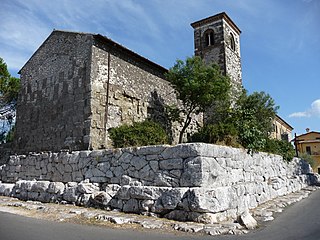
Segni is an Italian town and comune located in Lazio. The city is situated on a hilltop in the Lepini Mountains and overlooks the valley of the Sacco River.

The Tabularium was the official records office of ancient Rome and housed the offices of many city officials. Situated within the Roman Forum, it was on the front slope of the Capitoline Hill, below the Temple of Jupiter Optimus Maximus, to the southeast of the Arx.

The Capitoline Triad was a group of three deities who were worshipped in ancient Roman religion in an elaborate temple on Rome's Capitoline Hill. It comprised Jupiter, Juno and Minerva. The triad held a central place in the public religion of Rome.
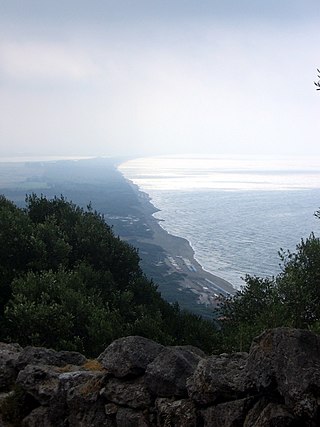

A Capitolium (Latin) was an ancient Roman temple dedicated to the Capitoline Triad of gods Jupiter, Juno and Minerva. A capitolium was built on a prominent area in many cities in Italy and the Roman provinces, particularly during the Augustan and Julio-Claudian periods. Most had a triple cella, one for each god.

The Temple of Jupiter Optimus Maximus, also known as the Temple of Jupiter Capitolinus was the most important temple in Ancient Rome, located on the Capitoline Hill. It was surrounded by the Area Capitolina, a precinct where numerous shrines, altars, statues and victory trophies were displayed.

The Basilica of Saint Mary of the Altar in Heaven is a titular basilica in Rome, located on the highest summit of the Campidoglio. It is still the designated church of the city council of Rome, which uses the ancient title of Senatus Populusque Romanus. The present cardinal priest of the Titulus Sanctae Mariae de Aracoeli is Salvatore De Giorgi.
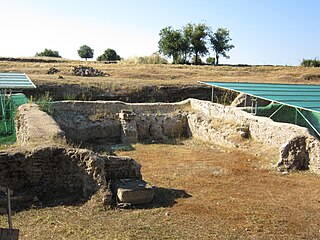
Gabii was an ancient city of Latium, located 18 km (11 mi) due east of Rome along the Via Praenestina, which was in early times known as the Via Gabina. It was on the south-eastern perimeter of an extinct volcanic crater lake, approximately circular in shape, named the Lacus Gabinus, and then during later times called the Lago di Castiglione, "lake of the fortification", after Castiglione, a mediaeval tower erected on the site of the ancient acropolis, or arx, of Gabii. A necropolis is adjacent on that side of the lake. At present, the former lake is entirely agricultural land. The ruins of the ancient city project from the fields next to the cliffs overlooking it, on both sides of the via. A municipium in Roman times, Gabii is currently located in the frazione of Osteria dell'Osa 10 km (6.2 mi) from the comune of Monte Compatri, of which it is a part, in the Province of Rome, Region of Lazio. The site is under new seasonal archaeological excavation.
Frank Edward Brown was a preeminent Mediterranean archaeologist.
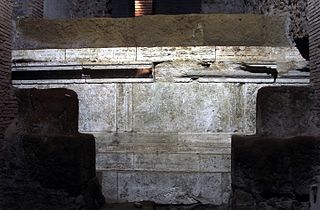
The Temple of Veiovis in ancient Rome was the temple of the god Veiovis, built sometime in the early 1st century BC.

The Temple of Jupiter, Capitolium, or Temple of the Capitoline Triad, was a temple in Roman Pompeii, at the north end of its forum. Initially dedicated to Jupiter alone, it was built in the mid-2nd century BC at the same time as the Temple of Apollo was being renovated – this was the area at which Roman influence over Pompeii increased and so Roman Jupiter superseded the Greek Apollo as the town's highest god. Jupiter was the ruler of the gods and the protector of Rome, where his temple was the center of Roman religion and of the cult of state.

The Temple of Diana was an edifice in ancient Rome which, according to the early semi-legendary history of Rome, was built in the 6th century BC during the reign of the king Servius Tullius.
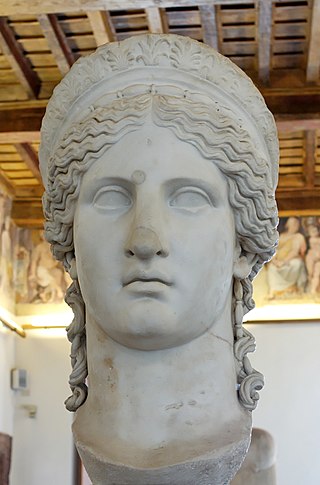
The Temple of Juno Moneta was an ancient Roman temple that stood on the Arx or the citadel on the Capitoline Hill overlooking the Roman Forum. Located at the center of the city of Rome, it was next to the place where Roman coins were first minted, and probably stored the metal and coins involved in this process, thereby initiating the ancient practice of associating mints with temples. In addition, it was the place where the books of the magistrates were deposited.
The auguraculum was a roofless temple oriented to the cardinal points, in which the priests of ancient Rome practiced augury and ornithomancy. The priest observer was positioned at the center of the temple, in a tent or a hut, and watched portions of the sky from which came the birds, which were marked out by stones placed along the perimeter of the temple. From this observation, the priest was believed to be able to predict the future.
Appius Herdonius was a Sabine who led an uprising against Rome at the head of slaves and exiles. With his troops, he managed, in 460 BC, to seize the Capitoline Hill and Arx at night.